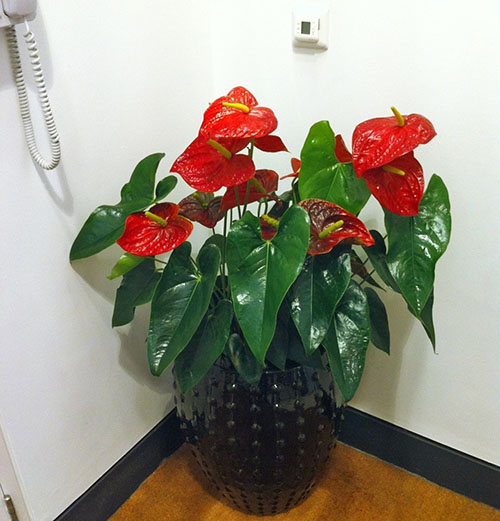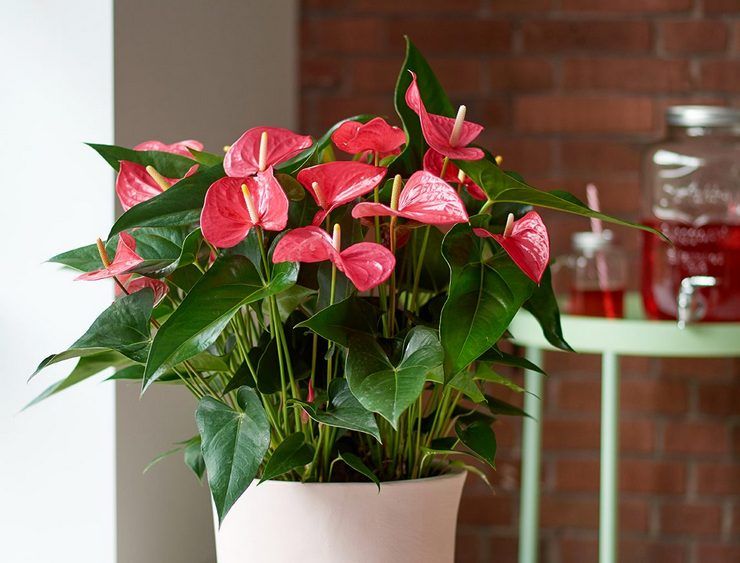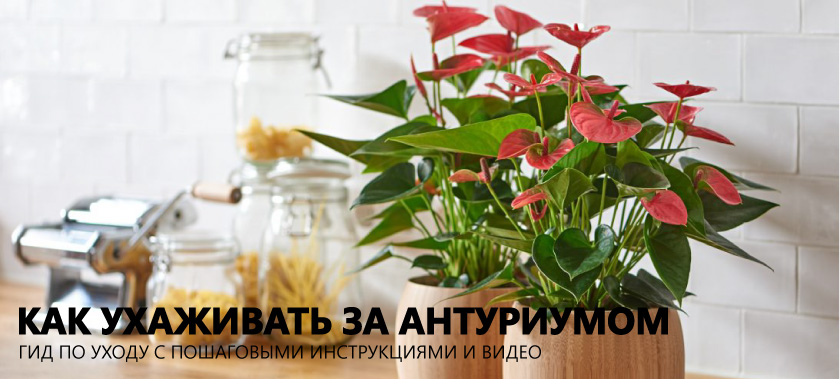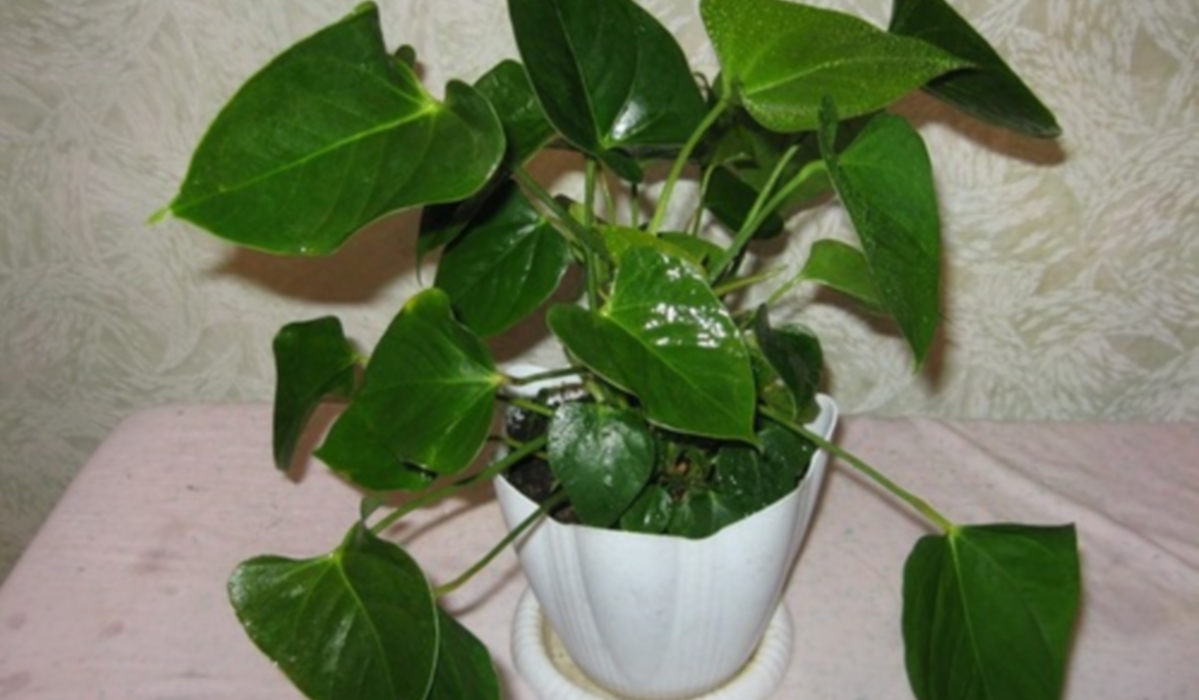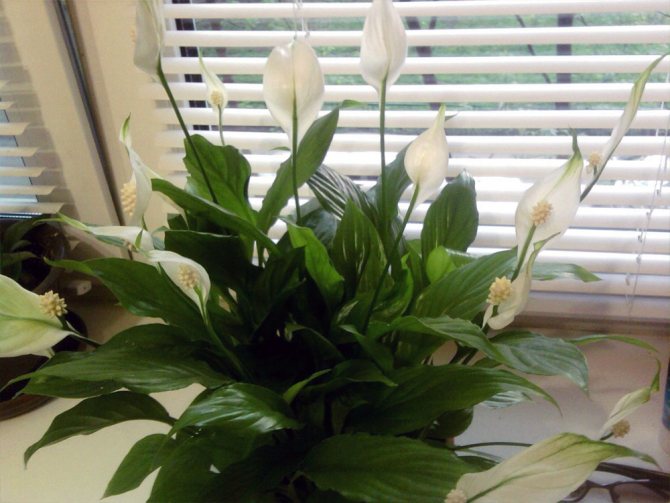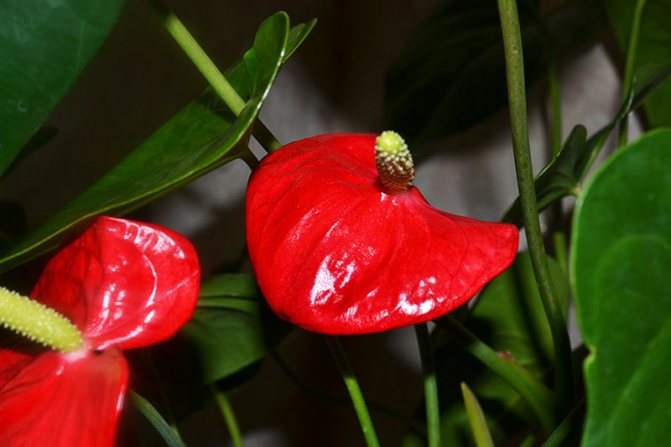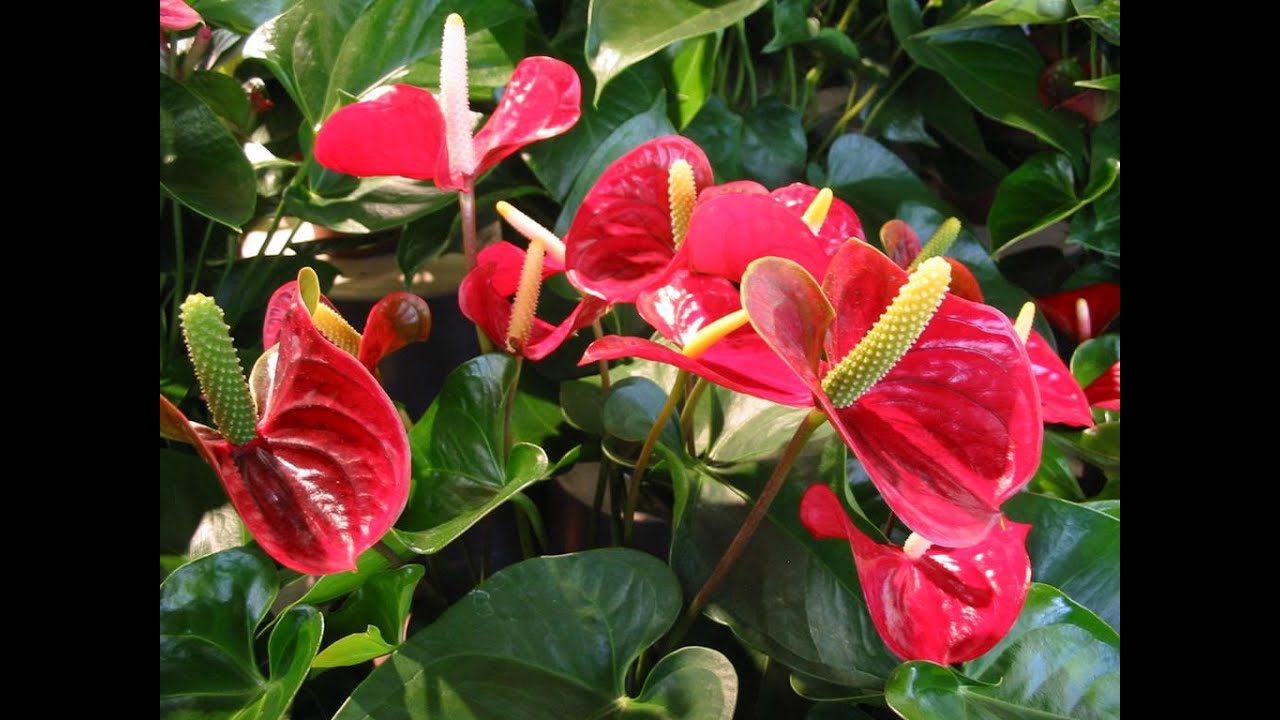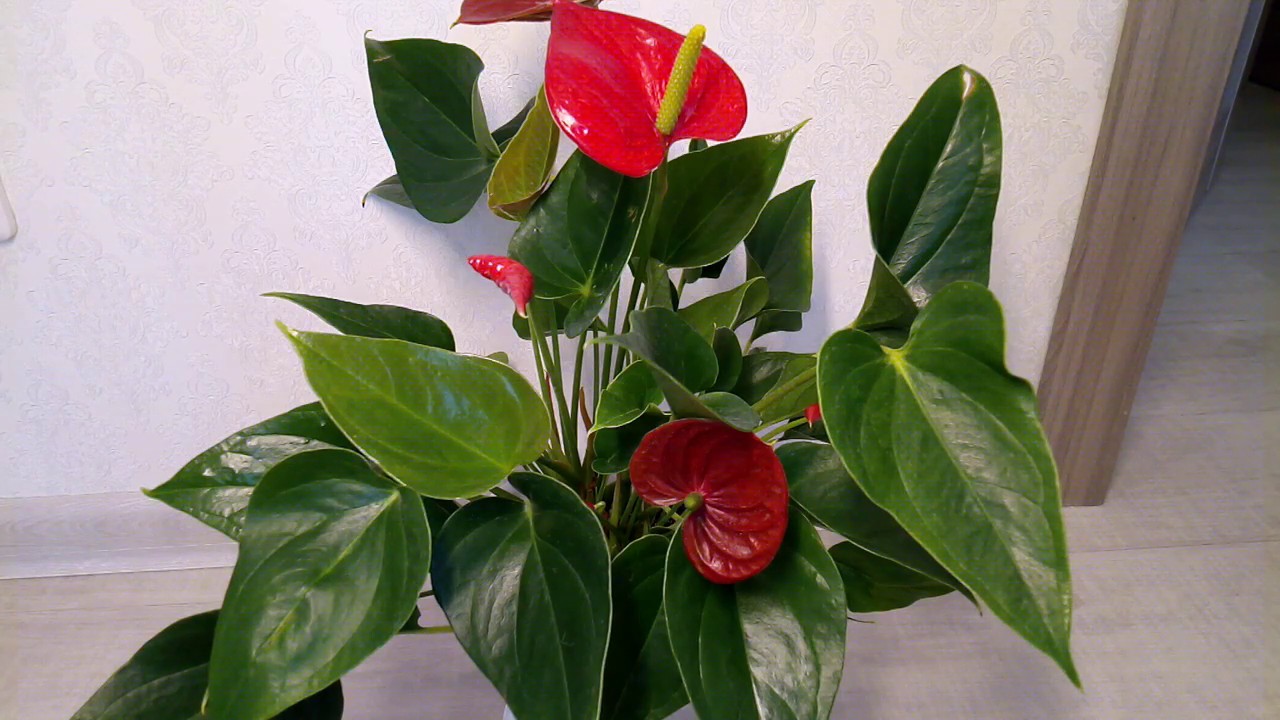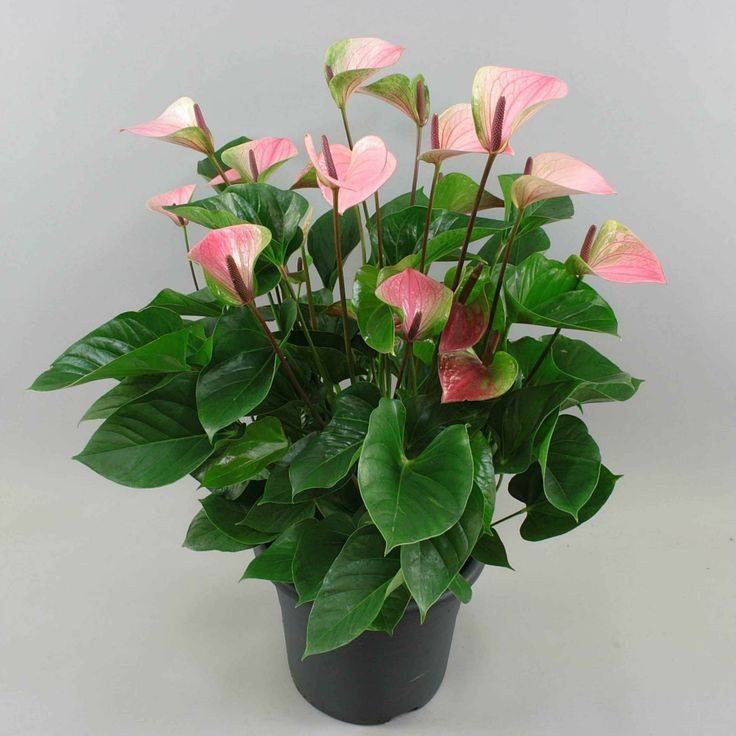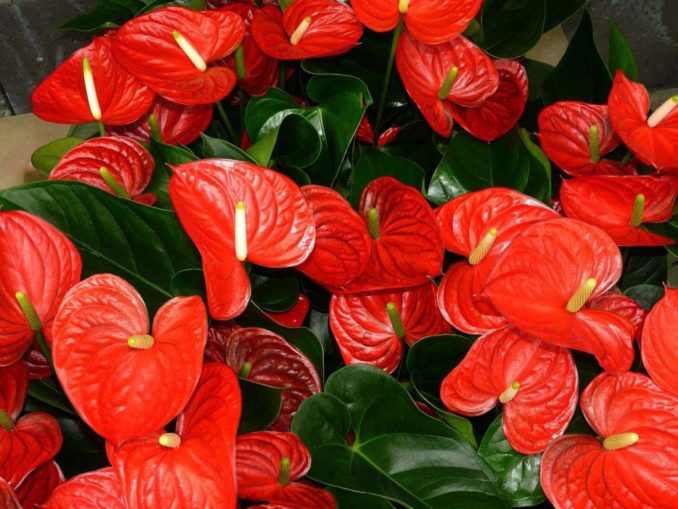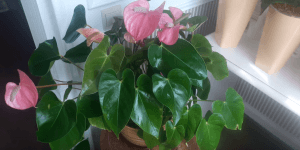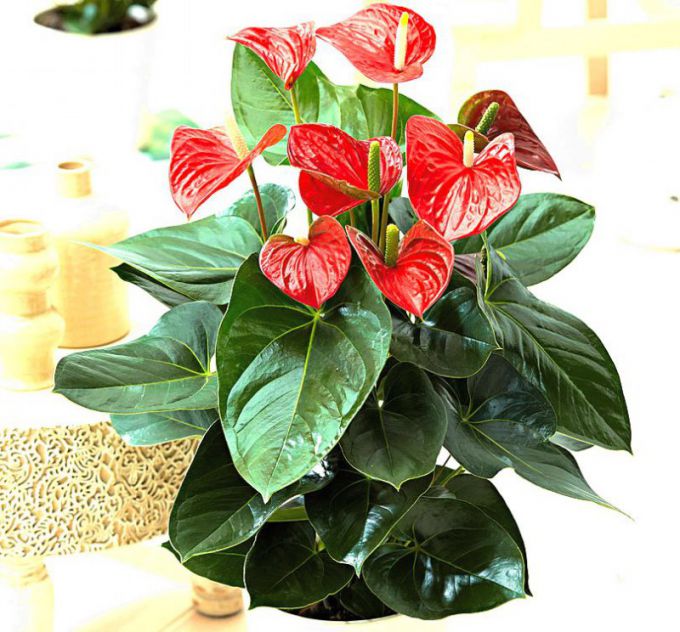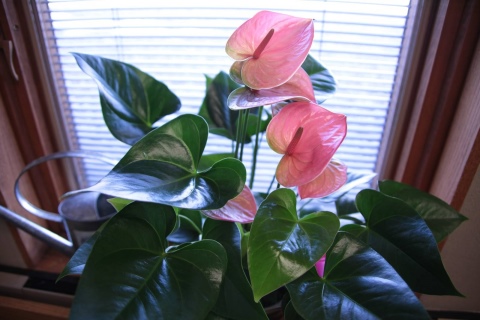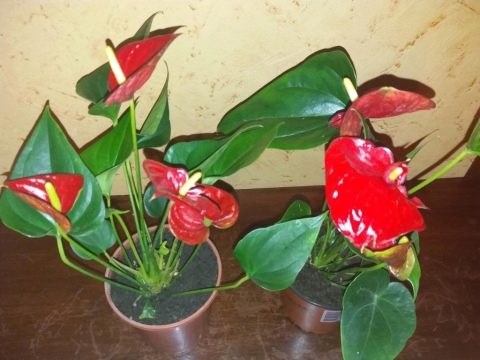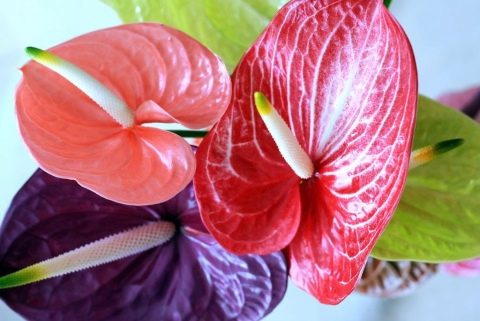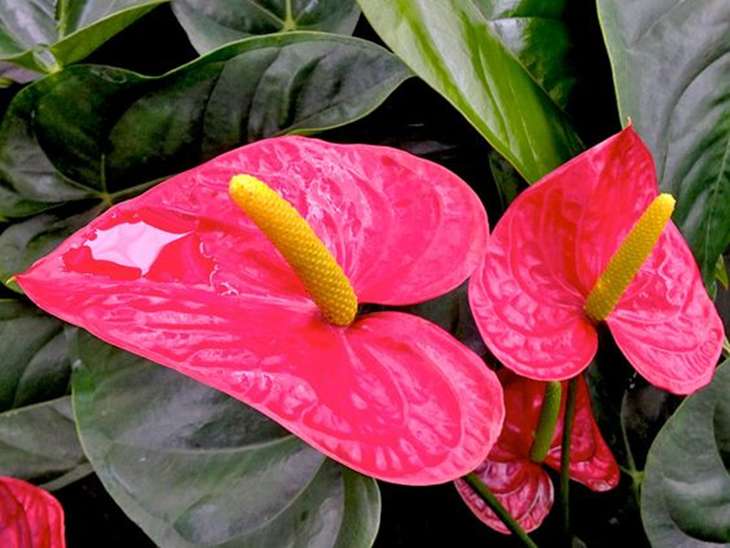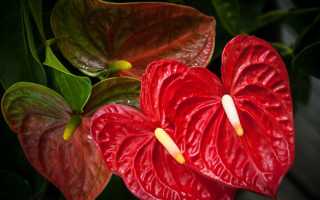What does this plant mean?

There is a beautiful legend about the origin of the anthurium flower.
The leader of one of the ancient Indian tribes saw a beautiful young girl from a neighboring tribe and desired to marry her. The bride was in despair - she was already in love, and the chosen one reciprocated her. By refusing the man, she brought trouble on her fellow tribesmen: the rejected groom was offended and went to war against the neighbors, deciding to take the beautiful woman as a wife by force.
It was decided to celebrate the victory and the wedding day on the same day: according to the established tradition, they kindled a festive fire. The desperate bride could not bear her new fate and decided to commit suicide by jumping into the fire.
The flame of fire engulfed her, dressed in a bright red wedding dress, and even the Indian gods who watched this action were imbued with the girl's act and decided to perpetuate her brave soul by breathing it into a beautiful bright red flower called anthurium.
Feng Shui
The peculiarity of anthurium, according to the ancient oriental philosophy of feng shui, is the ability to relieve a person of depression, bring harmony to his thoughts, and tune in a positive mood. In addition, the flower helps to clarify consciousness and increase intuition.
He knows how to attract money into the house, but only on condition that decent people with bright thoughts live in it. Anthurium reacts very subtly to the emotional atmosphere in the house and is a kind of negative catalyst: bad energy is destructive for it.
For men

Anthurium is a symbol of male potency and endurance. If a man has problems in the sexual sphere, the energy of the plant contributes to the return of its former power and masculine strength.
For women
The people often call the flower "male happiness". It is believed that an unmarried woman should have a pot with this plant in her house to attract male energy into it. If buds appear on a flower in a short time, this means that soon a man will appear in the life of its mistress.
Reference! Anthurium has its own "second half" - a related plant spathiphyllum, which is commonly called "female happiness". For a single woman, the appearance of this plant in the house promises a change in marital status, and for a married woman, early motherhood.
Anthurium is often paired with spathiphyllum, which has delicate white flowers. Both plants, planted together in one pot, symbolize a strong and harmonious family union, in which idyll and mutual understanding reign.
Anthurium - signs and superstitions
Our ancestors were not in vain to be wary of home flowers, because many of them are dangerous to keep in your home. Some, on the contrary, have magical abilities to positively influence a person's life. Anthurium also belongs to such plants.
Anthurium - "male flower", as it is often called, or "male happiness" - according to legend, in the past was a beautiful girl who threw herself into the fire because of unrequited love. Since then, anthurium brings happiness to any worthy man. And single women are advised to keep anthurium on their windowsill, since it attracts people of the opposite sex to the house. In a family home, anthurium promotes mutual understanding in relations between spouses and at the same time has a positive effect on male strength. Anthurium, which has powerful energy and healing properties, is recommended for people prone to nervous disorders and suffering from cardiovascular diseases. In addition, this plant attracts money to the house.In order for the positive energy of anthurium to manifest itself, it is necessary:
- set a flower on the east side and preferably in the bedroom;
- remove all electrical appliances from the plant pot, since they absorb the energy of the anthurium.
The energy of anthurium has the greatest power during flowering.
Diseases, pests and home treatments
Anthurium care also includes disease and pest control. Consider the main problems and methods of helping the plant:
- Flower leaves can turn yellow not only from lack of water, fertilizers, freezing, sunlight, but also from chlorosis. To get rid of the last misfortune, they must be sprayed with algae extract or iron chelate.
-
Brownish spots indicate abundant watering, and black and sluggish spots indicate improper transplantation and damage to the roots. If there are specific spots, bloom, dryness on the leaves and trunks, the diseased plant must be isolated and treated. For the prevention and treatment of rust (brown spots of different sizes), you need to wipe the plant with Bordeaux liquid, and get rid of the affected leaves.
- Areas with sooty fungi that appear on the traces of aphids' vital activity should be cut off and the whole plant treated with potash soap.
- With significant humidity and high air temperature or sudden changes in it, as well as problems with care, a white bloom of powdery mildew may begin to expand. To eliminate it, you need to apply fungicides.
-
Due to excessive watering, poor drainage and transplantation into contaminated soil, soil fungi can appear, provoking root rot. It is necessary to promptly remove the damaged areas of the plant with a scalpel, treat the sections with a pink solution of manganese and provide it with optimal conditions of detention.
- At high humidity and low temperatures, a gray bloom appears on dry areas of the leaves, namely, gray rot. The flower should be isolated immediately, the room temperature should be raised, and watering should be reduced. Spraying and watering with Oxyhom and Topaz preparations is recommended. The spores of the fungus also enter the soil, so it must be replaced, and the affected roots must be removed.
- The main pest of anthurium is aphids, which suck out all the nutrients. To get rid of it, repeated processing of the leaves with a solution of Pyrethrum or Karbofos helps.
-
Another insidious enemy is the shield. It is smaller than aphids, it is difficult to notice it. If bugs are found, you need to quickly apply insecticides and carry out mechanical cleaning of the plant.
- When thrips appear (their activity can be recognized by the black dots on the back of the leaves), the flower must be isolated, treated with an insecticide.
- If a thin web has enveloped the leaves, stems, inflorescences - this is a sign of a spider mite. First of all, you need to clean everything from the cobweb, wipe the pot and objects nearby, treat the plant with laundry soap.
It will also be interesting: Dendrobium Orchid - home care and flower transplant?
Why anthurium does not bloom - the main reasons

Anthurium is renowned for its exquisite bloom. It was the "plastic peduncles" that made the plant popular all over the world. Very often, culture is called the flower of male happiness and is gladly given to loved ones.
It is easy to care for a flowering bush. It requires a minimum of attention from the grower. But it happens that an adult plant refuses to form peduncles.
And then the florist begins to worry why anthurium does not bloom, but only releases leaves, although all the rules of agricultural technology are followed.
- 1 Reasons for the lack of flowering
- 2 Proper care of the plant
Proper plant care
Loading …
If the anthurium does not bloom, what to do with it becomes a real problem. Beginners, wishing to achieve the formation of peduncles, begin chaotic care, making many mistakes.
Optimal conditions of detention:
- The bush needs a sufficient amount of light. When illuminated for more than 12 hours a day, the plant blooms stably. If in the spring the leaves stretch out and become pale, it's time to think about artificial lighting.
- Planting in a suitable substrate promotes the growth and development of flower stalks. If the plant is planted in heavy soil, it should be transplanted immediately. The best soil for epiphyte is a mixture of peat, earth, sand, charcoal. How to make anthurium bloom at home - plant it in loose, breathable soil. For the formation of peduncles, the root system must be well ventilated and continuously replenished with oxygen.
- Planting the plant in a suitable pot. Anthurium aged 4 and more years is transplanted every 4 years. Young specimens are transferred to containers 3 cm more every spring. The procedure for "moving to a new home" can be carried out during the entire warm period from March to September.
- Cool wintering in a room with a temperature of no more than 18 degrees Celsius promotes the laying of flower buds. In December and January, it is advisable to stop fertilizing, reduce watering, and lower the temperature for rest. The resting phase in anthurium lasts 35-40 days.
- For abundant flowering, the balance of trace elements in the soil is extremely important. Potassium and phosphorus are the main components responsible for the abundance and duration of flowering. Anthurium can be fed with universal complex fertilizers for flowering crops. For example, fertilizer "Ideal" will help to achieve gorgeous flowering in the first year of cultivation. It is advisable to spray the crown of the bush with nutrients Bud, Ovary, Leroy Merlin.
It also happens that the florist is confident in the correct care of the plant.
He provided him with all the best and necessary: diffused light for a long time, watering and spraying in accordance with the recommendations, nutrition and preventive measures.
There are tricks on how to make anthurium bloom: at the beginning of spring, the plant is stressed - watered with soft water of 50 degrees temperature. This procedure can only be performed once a season.
Important! After rooting, Anthurium blooms in accordance with varietal characteristics. Some varieties bloom in the first year, and others after 4 years of successful cultivation.
Anthurium blooms continuously, changing inflorescences. One peduncle stays on the plant for several months in a row, delighting with its rich color
Proper care, attention and care of the grower will help to extend its sophistication to infinity.
How to make Anthurium bloom?
Indoor anthuriums are potentially capable of blooming from February to November, that is, almost all year round, stopping only in the coldest and darkest winter months; in addition, their flowers are unusually durable when cut and remain unchanged for up to four weeks. For such a fabulous flowering, these plants need appropriate conditions, the observance of which requires considerable experience and knowledge.
The main problem is to find such a balance of light, temperature, soil and humidity that will remind the anthuriums of their native high-mountain rainforests and, perhaps, they will agree to inhabit and reproduce in your apartment.
Creating an appropriate microclimate includes providing bright, but diffused illumination; long enough throughout the year.
Temperature regime
Summer temperatures should be maintained at 20-25 degrees, winter temperatures in the range of 16-18 degrees.
The soil temperature should not be lower than the air temperature, therefore anthuriums are planted in plastic containers. These containers should not be deep - but not too wide, otherwise the growing of roots and children will go, and not flowers.
Air and soil
The air saturated with water vapor should be fresh - but without drafts.
The soil is moist - but not wet.
Top dressing is needed - but fertilizer solutions should not be too concentrated.
Compliance with all these "ifs" and "but" is the main condition for the constantly blossoming "male happiness".
And now, finally, your anthurium has blossomed - but it's too early to calm down. After a while, the bright red bedspreads turn green, or the deep pink variety turns white, losing color. This is a normal phenomenon, as these plants fade - and the flowers that have become obsolete must be removed.
It also happens that you have acquired a luxurious variety with numerous large flowers - but at home it somehow thinned out, crushed and forms new inflorescences reluctantly.
This situation may arise due to the fact that during the commercial cultivation of anthuriums in greenhouses, gibberellins are used to improve the presentation - phytohormones that accelerate the growth and general development of all parts of the plant.
Anthurium - leaves turn yellow and dry
Anthurium is a plant that easily tolerates threats from pests. But many people have problems with growing it quite often. The most common that happen to this flower: leaves turn yellow and dry, spots appear. Of course, all gardeners are interested in how to save the anthurium when its leaves dry.
A healthy plant blooms for several months in a row, while it manages to grow simply gorgeous foliage
If you are the lucky owner of this luxurious flower, but it has begun to look unimportant, you should think about why your anthurium leaves dry or spots appear. As a rule, diseases can arise from improper care of him
Anthurium - what to do if the leaves dry?
Why, for what reasons do the leaves of anthurium turn yellow and dry? This question torments all amateur flower growers. If you are faced with this annoying problem, we will tell you what to do.
The very first and most common reason is improper lighting. Try to move the flower to a brightly lit area without direct sunlight. Direct rays can cause burns.
The second reason is a drop in temperature. Usually this problem is encountered during the winter period. When the temperature drops to 10-12 ° C, the leaves begin to become covered with brown spots, the lower leaves turn yellow, and growth slows down. To avoid this, you should move your flower to a warmer area and limit abundant watering. The most suitable temperature for anthurium is 22-25 ° C.
The third reason is humidity. If the yellowing of the leaves of your flower is massive, then this may be a root problem due to excessive moisture. To eliminate this problem, the flower should be pulled out of the pot, and the roots should be carefully examined. If rotten parts are found, they should be cut to healthy tissue and the anthurium should be planted in fresh soil.
The fourth reason is an overabundance or shortage of fertilizers. If you find yellowing leaves after feeding, you should take a break from this procedure, and best of all, replace the entire soil.
Uniform yellow large stain on the sheet may indicate that the flower does not have enough fertilizers, then, of course, top dressing should be done.
The fifth reason may be orange aphids. When aphid flower is damaged, its leaves turn yellow, dry up and wrinkle, young shoots and flowers fall off. In this situation, you need a tincture of tobacco, it will help get rid of aphids and save the plant.
The sixth reason is mealybugs. The leaves affected by them are covered with brown spots. However, they can infect not only leaves, but also young shoots. Small cracks with brown edges form in the sprouts. "Karbofos" will help to eliminate this problem.
Another reason may be fungal diseases. Although anthurium is rarely affected by such diseases, sometimes it happens. And if this happened, then the plant needs certain care and treatment:
- Gray rot. At first glance, it resembles a grayish coating in the form of dust. If you notice such a bloom on your flower, first move it to a well-ventilated area, as high humidity can spread the disease quickly, and carefully remove all damaged areas. Then spray the flower with Topsin.
- Septoria is a fungal disease that can also affect anthurium. In case of defeat by it, dark spots with a light border will appear on the leaves. Copper sulfate will help you with this ailment. But before you start treating the plant with vitriol, all affected foliage must be removed.
Anthurium home care secrets
How to choose a flower pot and soil
The anthurium pot is suitable as close as possible, preferably elongated.
The roots of the flower love space in length, for them it will come in handy.
In such an elongated pot, he will not waste his energy on overgrowth of roots. And the soil will not acidify.
Anthurium blooms only when it has mastered the whole clod of earth in the pot with roots.
The flower loves oxygen, so the earth for the anthurium must be breathable.
Holes can be made in the walls for better air flow.
Fill the pot with peat and moss, or the soil can be mixed with expanded clay and filled.
Anthurium blooms as much as possible and takes root well in a loose substrate. There are many options here
In addition, the soil for anthurium is prepared by mixing the soil in half with the coconut substrate.
Charcoal and crushed pine bark are used as an additive for air conductivity.
If you grow anthurium in a purchased substrate, then the soil for orchids is suitable.
Choosing a place for anthurium
Lowering the temperature below 16 degrees Celsius stops the growth of the flower, take this into account in winter.
The anthurium flower does not like drafts, the plant is thermophilic.
But keeping it near heating batteries is not worth it, they dry out the soil inside the pot and dehydrate the plant.
In summer, on the windowsill on the south side, the plant can burn in direct sunlight.
He needs good lighting, but only so that the sunlight is diffused.
Anthurium will feel good on the windowsill on the east side.
Here the sun comes only in the morning hours,
How to water anthurium.
This type of plant loves moderate watering and high humidity. The flower does not tolerate dry air.
You can put a container of water next to the flower so that it gradually evaporates.
Or you need to spray regularly with a spray bottle.
You need to spray with warm water with care so that dark spots do not appear on the leaves.
To avoid problems, it is better to spray air around the plant.
Soft water is best for watering. Soften water hardness by adding lemon juice.
Both over-watering and over-dried soil can cause plant death.
Anthurium transplant.
When a flower reaches the age of 5 years, it must be transplanted 1 time in 2 - 3 years.
Up to this age, young plants are transplanted annually.
Early spring is considered the best time for such an event.
In order for the horses to have the opportunity to gain a foothold, it is not necessary to tamp the soil strongly when planting.
Basic requirements for flowering anthurium
Anthurium blooms differently depending on the variety. For some, the beginning of summer is acceptable, the flowering of the latter falls in autumn, even varieties that bloom in winter are cultivated today. Many growers also note these Anthurium species that bloom all year round. Therefore, it is never too late to start stimulating the plant to eject the inflorescences.

Despite the state of the anthurium and its age, work begins with correcting the mistakes made, implying compliance with the basic requirements of the plant.
Lighting
An excellent place for the growth of anthurium is partial shade.Pots with this flower should be placed on eastern or western windowsills, which allows the plant to have a long daylight hours and diffuse sunlight. In such conditions, anthurium does not waste energy on restoring burnt stems and foliage. If we are talking about the winter growing period, then fluorescent lamps must be used to ensure long daylight hours.
Temperature regime
Cold and heat are unacceptable for anthurium. A favorable temperature for its cultivation and flowering is considered to be +18 .. + 22 ° С. This condition is necessarily fulfilled in both cold and warm months of the year.
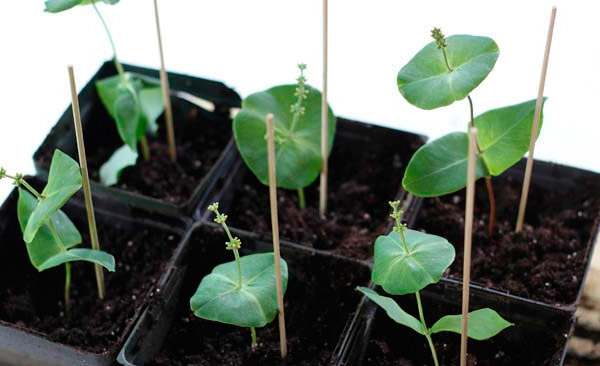
Watering organization:
- Anthurium responds with abundant flowering when irrigated with settled water at room temperature without chlorine impurities.
- The intervals between watering should not exceed four days in the warm season and seven days in autumn and winter.
- The need for watering an indoor flower is determined by the degree of dryness of the top layer of the planting soil - it should not stick to the hand and should not form cracks.
- To ensure a sufficient level of humidity in the warm season, anthurium foliage should be additionally sprayed from a spray bottle. When performing this procedure, it is necessary to ensure that water does not fall on the blossoming inflorescences.
Fertilizer
Anthurium is whimsical to feeding with nutrients, due to which the inflorescences are either absent, or are weak and few in number. The plant does not tolerate both their deficiency and their excess.
Therefore, you should always be guided by the following scheme:
- only rooted samples need to be fertilized without signs of pest infestation;
- for fertilizing, you should use a complex liquid fertilizer for flowering indoor plants, for example, Agricola, Fertika-Lux, Ideal;
- fertilizers should be applied to the soil no more than once a week during the active growth phase (you need to start at the beginning of March and finish at the end of August);
- the recommended one-time dosage of fertilizers should be divided by two to three times;
- before fertilizing, the flower is watered abundantly in order to prevent scalding of the root system.
Correct fit and transplant
Often, breeding anthurium at home begins with buying a plant at a flower shop. Therefore, after it has faded, it needs to be transplanted.
This is done in order to:
- soil renewal;
- providing the root system with optimal conditions for full development;
- achieving a more abundant long-lasting flowering.
In order for the anthurium to quickly begin, it is transplanted by the transshipment method, without injuring the root system. The plant is transferred to a more spacious shallow pot with a renewed weakly acidic substrate, consisting of peat, bark of coniferous trees, charcoal, sand, expanded clay chips in a ratio of 1 / 0.5 / 0.5 / 1 / 0.5.
Anthurium also accepts loose forest soils, turf. The lower the density of the soil, the more oxygen enters the roots of the plant, which ensures its vigorous growth and the formation of new inflorescences.

After replacing the flower purchased containers, the anthurium is transplanted once a year for five years. Subsequently, the number of transplants is reduced to once every three years. A favorable time for transplanting a plant, which has been cultivated for several years, is the active growth phase from March to September inclusive.
Breeding methods
A tropical houseplant is propagated in several ways:
- Seeds. This is a long and difficult way to breed quickly. To obtain healthy seeds, the flower is pollinated. A drop of pollen is transferred from one flower with a cotton pad to another. At the end, a fruit with seeds will appear. It is carefully cut and left to mature for 8 months. Then the seeds are removed from the fruit with tweezers and washed with a solution of potassium permanganate.They are sown in moist soft soil and covered with foil or glass jars. The first shoots should hatch in a couple of weeks. Small seedlings are rooted in soil consisting of mullein, peat mixture, leafy soil and coal. Then, already in the course of growth, larger pots are selected.
- Cuttings. The upper part of the shoot is cut off and rooted in a moist substrate. A stalk of 15 cm is suitable. Vermiculite is added to the soil for the rapid formation of branched roots. After a month, greens can be transplanted into individual flowerpots.
- Division by processes. Side shoots are cut off from the main plant and planted in a prepared container. Such a young shoot takes root quickly.
All these manipulations are best done in the spring, and not during the dormant season, and only if the mother plant is not sick with anything.
Pests and diseases
Almost all types of anthurium are resistant to indoor conditions, so they are often used to decorate various interiors. However, if optimal conditions are not observed, weakened specimens can be susceptible to diseases or pest attacks. To prevent insects from multiplying, you should regularly cut off dried leaves and faded inflorescences. All plant residues are immediately thrown away.
Pests
Anthurium has dense leaves, so insects rarely attack it. The main pests that threaten the plant are:
- Shields. They are recognized by sticky secretions on the leaves, and over time, brownish wax plaques - shields become visible. With a weak lesion, a soap solution helps. If there are many pests, the bush is treated with Aktara solution.
- Aphid. It can enter the room through open windows or it can be brought in with a bouquet of cut flowers. In any case, a pest may well take a fancy to a houseplant. Fitoverm will help to get rid of aphids.
- Mealybug. It is clearly visible on the leaves of anthurium. Scorm is a small insect covered with white cotton-like secretions. Pest females suck sap from the leaves, damaging the leaf plate. If a mealybug is found, the plant is treated twice with "Fufanon", with a week break between treatments.
Diseases
Anthurium suffers from diseases more often than from pests. Diseases are caused by pathogenic fungi and high humidity. The ability to resist disease will depend on how you care for the anthurium. In good conditions, the plant has strong immunity and is able to resist ailments.
Septoria (white spot) appears as irregular gray or brownish spots with a yellow border. Usually the disease occurs on plants suffering from lack of light and nitrogen deficiency. The disease progresses with high temperature and humidity. The damaged parts are removed, and the plant is treated with Abiga-peak. Since the spores of the fungus can also be in the soil, it is also processed.

Septoria on the leaves of anthurium
Root decay is the most common anthurium problem. This disease is associated with improper watering. In this case, the leaves turn yellow and wither. A diseased plant is taken out of the ground, the root system is examined and rotten areas are removed. The slices are sprinkled with crushed charcoal and left for a couple of hours in the open air. When the slices are dry, the flower is planted in a new substrate. Spray the leaves with Epin and cover the plant with a transparent bag.
Important! An impromptu greenhouse is removed when the anthurium is fully restored. With proper care, anthurium grows healthy and can bloom almost all the time.
This valuable decorative leafy and at the same time beautifully flowering species is often used for group compositions in the interior of the premises and in winter gardens. The variety of colors allows you to make bright flower arrangements and delicate bouquets. The plant is popular with amateur flower growers and professional designers.
With proper care, anthurium grows healthy and can bloom almost all the time. This valuable decorative leafy and at the same time beautifully flowering species is often used for group compositions in the interior of the premises and in winter gardens. The variety of colors allows you to make bright flower arrangements and delicate bouquets. The plant is popular with amateur flower growers and professional designers.
Propagation of anthurium by cuttings
Cuttings root much faster than leaves taken from anthurium. The first roots appear within a week from the moment of planting. When they reach a length of 2 or 3 centimeters, they are transplanted to a permanent place. To prepare the cutting for planting, it is necessary to carry out the following operations: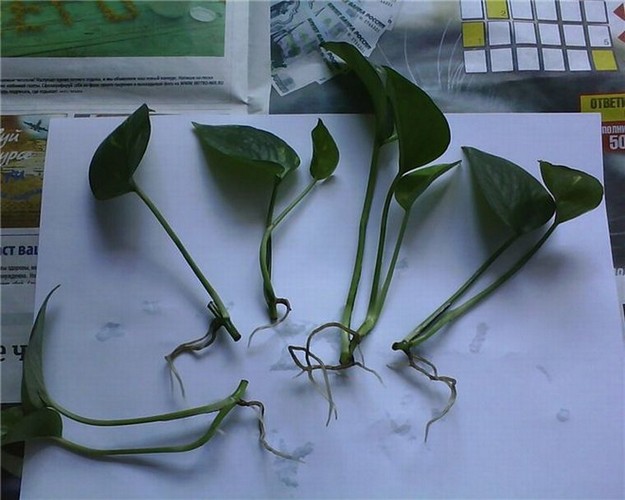
- The length of the handle ranges from 5 to 8 centimeters.
- The cut of the plant needs to be dried a little in air (no more than 10 minutes).
- The leaf is removed.
- The stalk is placed in a moist substrate, for example, a mixture of peat and sand in equal proportions.
- The plant is covered with plastic wrap or a plastic cup and moved to a warm place.
Why is it called that?
According to legend, "male happiness" symbolized a luxurious enchanted girl. An Indian leader, malicious and cruel, wanted to marry her, despite the fact that the girl loved another and was against this marriage with all her might. To save herself from the hated marriage, the beauty put on a red wedding dress and burned herself in a bonfire. But the gods in heaven decided that this was too cruel punishment for her and did not allow her to disappear from the face of the earth. They transformed her into a wonderful scarlet flower.
Perhaps this beautiful legend was the reason for the emergence of various superstitions associated with "male happiness". According to signs, this flower is able to give men unprecedented spiritual strength, helps to find harmony with themselves and the world around them, and gain confidence. That is why the flower is often given to men, especially since the magical properties of the flower increase if it is accepted as a gift.
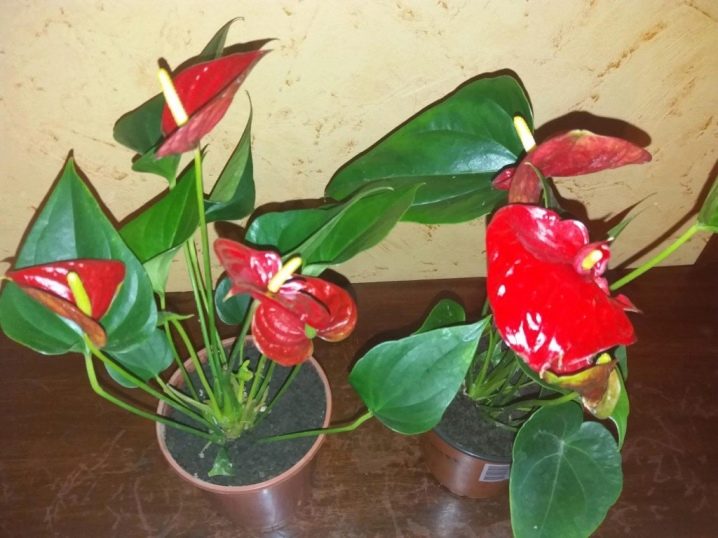
In addition, according to legend, the flower has the following properties:
-
improves health, therefore it is recommended to start anthurium in a house where there are cores;
-
attracts positive energy that helps to improve the financial situation of family members, but in this case it is necessary to start several plants at once and carefully care for them;
-
harmonizes relationships, makes the aura in the house favorable, the relationship stable, strong, and to enhance this effect, pair with "male happiness" spathiphyllum, which is by definition a "female flower".
What if the plant wilts after the procedure?
If the plant was cut correctly and its rooting was successful, but the anthurium soon began to wither, then some mistakes may have been made in caring for the renewed plant.
The renewed plant can begin to wilt if:
- direct sunlight falls on it or, conversely, the lighting is insufficient;
- high room temperature and dry air;
- excess nitrogen fertilizers;
- excessive or insufficient watering.
When all these problems are eliminated, the plant should bounce back and start growing. If the leaves still do not rise, then we can assume that the flower was infected with chlorosis or fusarium during transplantation. In the first case, iron should be added when fertilizing, and in the second, anthurium should be treated with fungicides.
The procedure for rejuvenating a plant does not require significant effort, and all of the above tips will help you avoid the typical mistakes of a novice grower.
If you find an error, please select a piece of text and press Ctrl + Enter.

One of the most common types of anthurium that is grown at home is the Andre variety. This is a fairly tall plant, capable of reaching 90 cm in height, but the stem is shortened, with a large number of aerial roots.The inflorescence of the cob is about 15 cm long, painted white or yellow, and the veil around it can be of the most varied colors and resemble a heart in shape.

